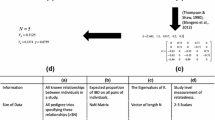Summary
Three main conclusions emerge from the foregoing discussion.
(1) The technique of correlation can be used to draw attention to the existence of genetic differences or of differences due to environment provided the selection of data is appropriate to the kind of differences we wish to detect.
(2) The belief that a comparison between observed correlations of relatives and correlations based upon purely genetical assumptions provides us with a measure of the influence of nurture is not justified, because of the close relationship between the distribution of gene differences and differences due to environment in populations of viviparous animals which live in families, especially when, as with human populations, the environment of different families may differ greatly.
(3) A balance sheet of nature and nurture, if it has any significance in the light of modern experimental concepts, does not entitle us to set limits to changes which might be produced by regulating the social or physical environment of a human population.
Similar content being viewed by others
References
Elderton (1923). “A summary of the present position with regard to the inheritance of intelligence.”Biometrika,14.
Engledow (1925). “Investigations on yield in cereals, II.Journ. Agric. Sci. 15.
Fisher (1925). “The resemblance between twins: a statistical examination of Lauterbach’s measurements.”Genetics,10, No. 6.
Freeman, Holzinger andMitchell (1928). “The influence of environment on the intelligence, school achievement, and conduct of foster-children.”27th Year-Book, N.S.S.E. Part 1, Chap. ix.
Haldane andCrew (1925). “Change of linkage in poultry with age.”Nature,115, 641.
Harris (1909). “A short method for calculating the coefficient of correlation.”Biometrika,7, 218.
Herrman andHogben (1933). “The intellectual resemblance of twins.”Proc. Roy. Soc. Edin. (in the press).
Hogben (1932). “Correlation of relatives on the supposition of sex-linked inheritance.”Journ. Gen. 26, No. 3.
Holzinger (1929). “The relative effect of nature and nurture influences on twins differences.”Journ. Educ. Psych. 20.
Krafka (1920). “The effect of temperature on facet number in the bar-eyed mutant ofDrosophila.”Journ. Gen. Physiol. 2.
Levy (1932).The Universe of Science.
Pearson andLee (1903). “The law of ancestral heredity.”Biometrika,11.
Sax (1926). “A general interpretation of ecological adaptation.”Bot. Gaz. 82.
Sewall Wright (1926). “Effects of age of parents on characteristics of the guinea-pig.”Amer. Naturalist,60.
Taylor (1931). “The relation of temperature to the heart-rate of the South African frog.”Journ. Physiol. 71.
Winton (1927). “A contrast between the actions of red and white squills. The rat-poisoning substance in red squills.”Journ. Pharm. Exper. Ther. 31.
Author information
Authors and Affiliations
Rights and permissions
About this article
Cite this article
Hogben, L. The limits of applicability of correlation technique in human genetics. Journ. of Genetics 27, 379–406 (1933). https://doi.org/10.1007/BF02981751
Issue Date:
DOI: https://doi.org/10.1007/BF02981751




